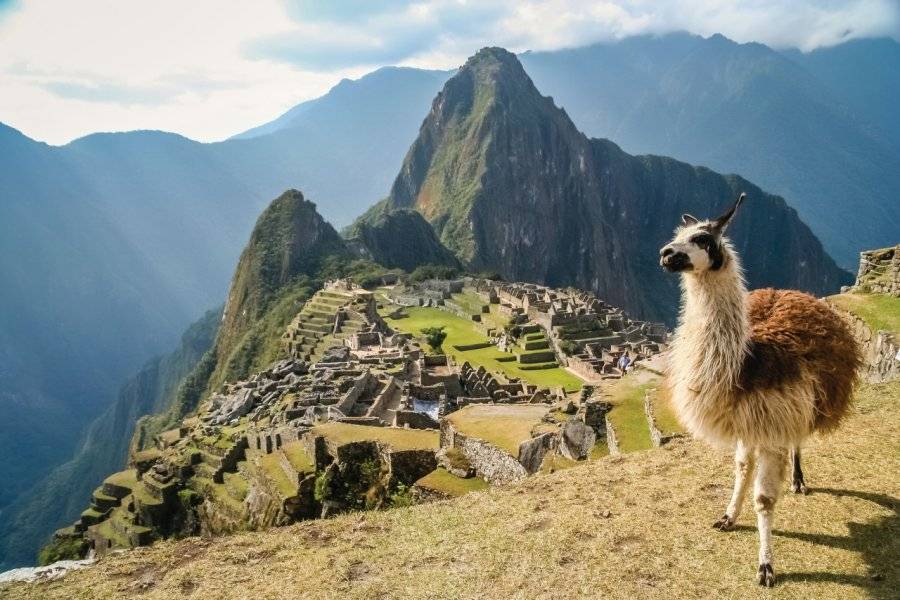MACHU PICCHU
Standing at an altitude of 2,430 metres, it is embedded in the landscape.
On the eastern flank are the two main agricultural and urban zones of the city, which is said to have been the last refuge of the acllas (Acllahuasi), the virgins of the Sun charged with perpetuating sacred rites.
The urban sector concentrated both secular activities, with residential quarters and sewers, and sacred activities, with temples, mausoleums and royal houses. The architecture itself separates the two worlds: rather crude for what concerns the life of the people, refined for the buildings of the nobility.
A grand staircase leads to a watchtower with a bird's-eye view of the site. Immediately below, a stone ensemble unites the ancient Tumba Real (or Mausoleo) guarded by a tower (Templo del Sol or Torréon). Las Escalinatas de las Fuentes and a series of sixteen fountains where ritual ablutions were apparently performed.
The complex adjoins the Residencia Real. A flight of stairs to the north leads to the Plaza Sagrada, which marks the entrance to the religious quarter. The central square is enclosed by several temples. It's here that the mysterious vibrations emanating from this site are perhaps best felt.
The Intihuatana, atop a pyramid that stands out clearly from the site, is the most famous. It seems to have served as a solar calendar. However, it is no longer possible to climb it.
So much for the general view from the Casa del Guardian, Machu Picchu's most famous vantage point (tour 1 or upper terraces on tour 2).
What was the site used for? Who built it? How was it built? Mysteries and historical polemics still abound.
Practical information. You can enter the site on your own, but we recommend the services of a guide. Private tours cost US$25 per person. At the entrance to the site itself, there are few French-speaking guides.
The site offers 3 main tours: 1 Panoramic, 2 Machu Picchu Classic and 3 Realeza. Tour 1 offers the best views, but does not take in the monuments. Tour 2 is the most complete. Tour 3, dedicated to the lower part of the site, allows you to explore certain monuments in greater detail.
Wayna Picchu and Montaña Picchu must be booked separately, and some entrances are only open during the high season: Intipunku, Puente Inca, Huchuy Picchu and Gran Caverna. It is possible to buy several tickets for the same date and combine them, offering a much more complete and exclusive experience.
Sales: full details of the tours are available on machupicchu.gob.pe and on the ticket sales site tuboleto.cultura.pe. There is a sales point in the village of Machu Picchu Pueblo where a few tickets are sold, but there is very little choice and a long queue.
Opening hours: visits are possible from 6 a.m. to 3 p.m., with a visitor quota for each slot. The first slot is in high demand, but it's only really interesting in the high season (June, July, August) when the weather is generally fine and clear. The evening time slot (3pm) is less popular and allows you to see the site gradually empty, which is quite poetic. The Huayna Picchu and Montaña Machu Picchu entrances are only available at 7 or 9 a.m., so if you want to see everything, you'll have to combine this with a second, earlier or later entrance.
Did you know? This review was written by our professional authors.
Members' reviews on MACHU PICCHU
The ratings and reviews below reflect the subjective opinions of members and not the opinion of The Little Witty.















Tout est à découvrir et si vous rêvez de la faire comme nous , n'attendez pas , c'est encore le moment car je pense que ça va devenir de plus en plus touristique. Nous sommes restés plusieurs jours à Cusco pour nous imprégner de la ville et il y a tant à voir aussi . J'ai dit waooouuuu plus d'une fois et même , je l'avoue, versé ma petite larme tellement c'est beau .